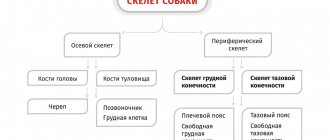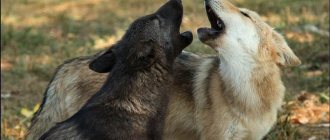on the penis (at the end, that is, at the base) sometimes some balls harden, similar to testicles. and the penis itself gets hard, is it supposed to be like that? what is this and why is it?(=
if you are looking for points or write to me “go to the vet” - please pass by) I ask those who understand to answer.
The penis, together with the scrotum, constitutes the external genitalia of a male dog.
The penis is divided into root, body and head.
The root and body of the penis are enclosed in the skin. Elastic skin also covers the head, but at the same time forms a folded cavity - the prepuce, or foreskin.
The head of the penis is significantly long and has two thickenings - anterior and posterior. The owner, who does not know the peculiarities of the structure of the dog’s penis, is in a state of fear when he one day sees how some balls suddenly swelled on the dog’s stomach, along the length of the penis. There should be no confusion, since nothing special happened. The posterior thickening of the penis has the appearance of bulbs. With sexual arousal, everything returns to normal. The urethral canal opens at the end of the head.
And one more feature. The head of the penis is based on a bone that reaches 8-10 cm in length in large dogs. It seems to be a continuation of the cavernous bodies of the penis and, tapering in front, is covered with cartilage in the form of a thickening. This complex structure, with the presence of powerful compressors of the veins of the penis, makes the dog’s sexual intercourse last a long time.
The physiology of various species is determined by their structure and the natural necessity of certain processes. But that doesn’t stop it from looking funny or strange. And dogs have this feature that often causes confusion and questions when you first encounter it.
Sometimes after sexual intercourse, the dogs do not disperse in different directions, but stick together for a while, turning their sirloins towards each other and spend some time like this. The Internet is filled with funny videos of dogs pressing their butts together, but this is not a natural anomaly, but a completely natural development of events that completes the mating and makes it more likely to conceive healthy, strong puppies.
Many owners do not know about the normality of mating, about the reasons for the phenomenon and are frightened when they see this process with their own eyes for the first time; they try to intervene, often only interfering with the natural course of things and making things worse.
Anatomy of the structure of the reproductive organs in dogs
Bitches vagina
The reproductive system of bitches consists of the ovaries, fallopian tubes, uterus, vagina, and loop.
The ovaries are attached to the body of the uterus by the uterine horns and are located in the abdominal cavity. The development and maturation of puppies occurs in the horns of the uterus. The body of the uterus, the entrance to the uterus and the vagina form a tube, which is lined inside with a mucous membrane.
The system ends with the external genital loop. Petya consists of the labia, and they are connected at the bottom by adhesions near the urinary opening and the clitoris. The clitoris consists of a cavernous body and many nerve endings. During an erection, blood flows to the clitoris and increases the sensitivity of the vulva.
The structure of the reproductive system in dogs
The structure of the penis in a male dog
The system consists of: the prostate gland, spermatic cords, testes, bulb, penis and prepuce.
Sperm is formed and matures in the testes; vital activity is supported by secretions from the prostate gland.
The testis is attached to the spermatic cord and sags in the scrotum. The male penis contains a bone inside that runs along the urethra.
When the dog is excited, blood flows to the penis, an erection occurs. The penis increases in volume and extends outward from the prepuce (foreskin). The prepuce protects the head from external influences by stretching the cranial muscle. The vas deferens is a narrow tube that originates from the tail of the epididymis. The duct passes into the ejaculatory canal, which is located at the base of the genitourinary canal.
Reproductive organs in dogs
The reproductive organs of both males and females may be underdeveloped due to pathologies, genetic diseases, and injuries at an early age.
The veterinarian will check your pet for infections or development of pathologies.
Genitourinary system of dogs
- Section: Anatomy and physiology of dogs
- The excretory and reproductive organs of a dog form one system, which is typical for mammals. Two kidneys are attached to the upper part of the abdominal cavity, protected by the last ribs. They filter the blood, removing unwanted or potentially toxic substances. The purified waste then enters the renal pelvis from where, with the help of peristaltic waves, it is transferred through the two ureters to the bladder. Urine is expelled outward through the urethra (urethra from the penis or vulva. The reproductive system is combined with the last part of the excretory system. The spermatic cords from the male dog’s testicles carry sperm to the urethra. In the female, the vagina leads to the vestibule - the vulva - through which the urethra discharges urine out.
INFLUENCE OF HORMONES
The male is always ready for mating. He is constantly sexually active and is attracted to the scent of a hormonally active female. The smell stimulates the pituitary gland at the base of his brain, which in turn “tells” the testicles to produce more male hormone and sperm cells. The female usually has two hormonally active sexual cycles per year. During proestrus (pre-estrus), which lasts about 12 days, her vulva swells and secretes a special secretion. During the actual estrus, which lasts about five days, the discharge stops, the ovaries release eggs into the fallopian tubes. Only then does the female choose a partner.
MATING TIME
A bitch can mate during her first heat, but due to her emotional and physical immaturity, the litter is often small and she is a poor mother. During subsequent heat cycles, mating is usually more productive. Ovulation can occur in different ways, but in most bitches it occurs between 10 and 12 days after the start of the cycle. Dog breeders prefer to mate bitches twice - on the 10th and 12th days or on the 11th and 13th days. Examination of vaginal smears under a microscope can provide reliable information about when the bitch ovulated. More accurate conclusions can be drawn by observing the level of hormones in the blood.
PAIRING
Usually before mating, both dogs flirt with each other. When the female is ready, she presses her tail to her side and stands still. The male climbs on her, inserts his penis, makes movements with his pelvis, and then ejaculation occurs. At the same time, his penis swells and the male finds himself “chained” with the female for about 20 minutes. If mating does not occur, then the bitch enters the metestrus stage (after-estrus), which lasts approximately 8 weeks (at this time the walls of the uterus thicken) and then for 12 weeks in the stage of sexual rest of diestrus, until the next estrus.
HOW THE SYSTEM WORKS
With the onset of maturity, sperm production begins in the mass of curved tubes in the male dog's testicles, located inside the protective sac (scrotum); it continues throughout life. Sperm is stored in the epididymis (at its base) and during mating travels along two spermatic cords to the prostate, where it mixes with a high-sugar transport medium. This gives the sperm cells nutrition and keeps them healthy. The prostate surrounds the urethra, and its enlargement can interfere with urination. Inside the penis is a bone through which the urethra passes. During mating, the area around the bone swells and “ties” the male to the female until the penis returns to its previous size.
HOW CASTRATION (STERILIZATION) IS PERFORMED
Castrating a male is relatively simple. A small incision is made just in front of the scrotum through which the testicles are removed and removed, reducing the production of male hormones. Sterilizing a female is much more difficult. An incision is made in the abdominal cavity and the internal genital organs from the ovaries to the cervix are removed. This stops all further breeding problems, including estrus, and eliminates the associated behavioral changes.
FORMATION OF STONES IN THE BLADDER Minerals in the urine sometimes crystallize into granules: this is how stones form in the bladder. This can also occur in the renal pelvis, resulting in painful kidney stones. Kidney stones are rare in dogs, but bladder stones are quite common. The deposited minerals irritate the inside of the bladder, causing straining and frequent urination, sometimes with blood. The formation of bladder stones depends significantly on the dog's diet. GENITAL SYSTEM OF THE FEMALE
How the system works
The two ovaries are attached to the top of the abdominal cavity, just behind the kidneys. They remain active throughout their lives, producing and releasing eggs, usually twice a year. The eggs pass through the fallopian tubes into the uterus, which has two distinct horns that meet at the cervix. During pregnancy, the embryos are arranged in rows in each horn. The cervix remains closed at all times except during estrus, when it opens to allow sperm to pass through, and during labor to release the puppies. Sometimes bacteria travel through the cervix into the uterus, causing serious illness. This most often occurs in older dogs and requires immediate veterinary intervention.
The structure of the male reproductive system
The male reproductive system includes the penis, prepuce, testes with spermatic cords and accessory sex glands.
The role of the accessory sex glands is to maintain the activity and viability of sperm and to secrete a special lubricating secretion during mating.
Sperm are produced in the testes. To produce normal sperm, a lower temperature is required than in the abdominal cavity, so when the male dog matures, the testes descend into the scrotum. Sometimes one or both testes remain in the abdominal cavity. This phenomenon is called cryptorchidism. Cryptorchid males are excluded from breeding, since this defect is hereditary. In a normal, calm state, the male penis is hidden by the prepuce (foreskin) and looks like an oblong leathery formation in the groin. Sexual arousal causes an erection. The cavernous bodies fill with blood and the penis increases in size, moving out from the prepuce.
Phimosis and paraphimosis in animals
Phimosis is the inability (total or partial) to remove the penis from the prepuce (the skin sac that protects the penis from the environment). In most cases, this kind of problem is associated with the narrowness of the marginal opening of the prepuce. This narrowness may be congenital or the result of a stricture (scar) at the site of inflammation or injury.
Congenital phimosis can be complete, that is, the opening of the prepuce is completely closed from birth. In this case, the puppy completely lacks urine flow and emergency surgical intervention is necessary; without veterinary care, such puppies quickly die.
Less severe cases of phimosis are detected during examination by a veterinarian. In some cases, with a small preputial ring, the act of urination becomes difficult and urine accumulates in the cavity. Outwardly, this looks like a constant leakage of urine; this often leads to secondary complications - preputial edema, secondary bacterial infections and balanoposthitis may develop. In less severe cases, as a rule, phimosis in dogs is detected during mating or in the case of painful and fruitless attempts at erection: the erect penis cannot pass through the narrow preputial ring, which causes pain to the dog.
Such attempts are not necessarily made during a planned mating, but are also observed when a young male “plays” with a soft toy. The pain experienced by a male dog during unsuccessful attempts at coitus causes a decrease in his libido.
When examined by a veterinarian, severe cases of phimosis in male dogs are diagnosed by the inability to remove even a non-intense penis from the preputial sac. In less severe cases, the diagnosis can only be made when the male dog experiences sexual arousal.
There is evidence about the hereditary nature of congenital phimosis, but so far it is not enough to say that the pathology is inherited.
Paraphimosis is a pinching of an enlarged or swollen penis in a narrow preputial ring, which the male dog cannot insert back into the preputial cavity. This is the opposite problem; with paraphimosis, an erect or swollen penis cannot be inserted back into the preputial sac.
This situation requires an emergency solution, since as a result of compression of the penis, there is stagnation of blood in it, progressive swelling, disruption of blood supply due to compression of blood vessels and, as a result, necrosis. In the glans penis of a male dog, blood circulation is disrupted, its surface quickly dries out, and with delay, necrosis develops, and blockage of the urethra can occur. Often the causes of paraphimosis are external factors - during mating, the hair, especially in long-haired breeds, entangles the base of the glans penis, forming a hair ring that prevents the outflow of blood; accordingly, the penis does not decrease and cannot return to the preputial sac, and the resulting stagnation leads to an enlargement of the glans penis.
With paraphimosis, a male dog experiences severe pain, the outflow of urine is disrupted due to strangulation of the urethra, the mucous membrane of the penis dries out, cracks and is often severely injured by the dog itself.
Paraphimosis is also observed in the case of erection with a moderate degree of phimosis (with a narrow preputial ring, the penis comes out in a non-erect state, but cannot pass through it in the opposite direction erect), and with a fracture of the os penis (penis bone).
With a number of other pathologies in male dogs, the head of the penis can also be exposed - for example, with congenital disorders of the structure of the bone of the penis, or with congenital shortening of the prepuce. The difference from paraphimosis is primarily that in this case the open head of the penis is observed in the dog in any state, not just in an excited state, and it does not enlarge.
The structure of the female reproductive system
The female reproductive system consists of paired ovaries, oviducts, uterus and loop (vagina). The ovaries produce eggs, each of which is covered with several layers of epithelium. The egg cell inside the epithelial membrane is called a follicle.
As the eggs mature and approach the period of estrus, the follicles enlarge. The cavity of the vesicles is filled with follicular fluid containing biologically active substances, hormones, etc. When estrus occurs, the follicles rupture and ovulation occurs. The ruptured follicle is transformed into a special formation called the “corpus luteum” and begins to produce a hormone responsible for the normal course of pregnancy with successful fertilization. Normally, the number of corpus luteum formed is equal to the number of ovulated eggs.
The owner of a bitch should be aware of possible pathologies of the reproductive system of bitches:
• Sometimes ovulation occurs without any outward signs of estrus. This state is called “silent hunting.” The bitch does not strive to mate and the most favorable period is missed. • In the opposite case, there are external signs of estrus, but ovulation does not occur. Your veterinarian can determine the presence or absence of corpora lutea by palpating the surface of the ovaries through the rectum.
Physiology of fertilization during mating
The reproductive system of bitches is designed in such a way that upon ovulation, the eggs are not ready for immediate fertilization and they mature in the oviducts. Ripening takes from 3 to 7 days. Spermatozoa remain viable for 7 days. Even if mating occurs when the eggs are not yet fully mature, fertilization will still occur.
An egg can only be fertilized by one sperm. This means that a puppy can only have one father. But if a bitch has mated with several males, the litter may contain puppies from different fathers. That is why it is necessary to carefully monitor the bitch after a planned mating.
Reasons for the development of folliculitis
There are several forms of skin pathology. Folliculitis can be superficial, moderate or deep. The most severe is the last form of the disease, which is practically untreatable. In addition, untimely initiation of treatment for pyoderma leads to alopecia at the site of injury and the formation of scarring.
The main cause of the development of folliculitis in dogs is infectious agents that enter the animal’s body. Fungal and bacterial pathogenic microorganisms, as well as viruses, can provoke inflammation of the hair follicles.
Factors that provoke a decrease in the resistance of the skin to the effects of various pathogens are:
- a sharp decrease in the body's defenses, caused by hereditary factors or the negative influence of systemic chronic diseases;
- violation of animal hygiene;
- helminth damage;
- disruption of the endocrine system, leading to disruption of metabolic processes;
- deficiency of vitamin-mineral complexes.
Activation of pathogenic microorganisms on the surface of the skin occurs when its integrity is violated. The development of inflammatory processes in hair follicles can be provoked by:
- mechanical damage;
- exposure to irritating factors - the use of shampoos and products that are not suitable for the animal;
- constant skin contact with dirt;
- seborrheic dermatitis;
- parasitic skin diseases (for example, demodicosis);
- allergic reactions, manifested in the form of skin rashes;
- diseases of the endocrine system with damage to the skin (for example, hypothyroidism).
Long-term use of immunosuppressive therapy can cause the development of folliculitis in a dog.
Skin diseases, which are not always provoked by pathogenic microflora, are often complicated by the activation of bacteria. One of the skin diseases often diagnosed in veterinary medicine is superficial pyoderma. In domestic cats, pyoderma is diagnosed much less frequently, unlike dogs. If initial folliculitis is not treated in a timely manner, it leads to dangerous consequences, such as furunculosis or inflammation of the subcutaneous fatty tissue.
Briefly about the main thing
- The skeleton consists of 290 bones, 262 joints. It supports the body and protects the organs.
- The jaw is one of the parts of the skull. An adult dog should have 42 teeth, and the bite depends on the breed.
- The internal organs are formed into the digestive, respiratory, circulatory, urinary, nervous and reproductive systems.
- Dogs' sense organs (with the exception of taste) are much better developed than those of humans. The main elements are eyes, ears, nose, tongue.
Do you know the location of your dog’s internal organs well? Share interesting facts about the structural features of these animals in the comments.
The role of mating in the fertilization of a bitch
For some reason, many people think that during the mating process, a male dog releases only sperm. This is a misconception - during sexual intercourse, a male dog secretes three types of secretions:
- In the first stage, lubricant is released.
- In the second stage, sperm is released.
- At the last third stage, which occurs only during mating, secretions of the prostate gland are released.
Let's look at each stage in more detail.
This stage can be called preparatory. The male excretes the first portion of fluid almost immediately after entering the female’s vagina. There are no sperm in this portion - it is a clear liquid that is needed for lubrication.
This is the most important stage during which the male dog secretes a fluid (ejaculate) containing sperm. The second stage occurs after the penis is already sufficiently erect and its bulb has reached its maximum width. The volume of secretion is very small - only 2-3 ml, but it is with this portion that the male releases all the sperm - up to 600 million per 1 ml of ejaculate.
So, it turns out that conception can occur without mating . But it’s not for nothing that nature created the “lock” mechanism.
This is the last stage in dog mating, during which the male secretes prostate secretions with a volume of up to 80 ml. These secretions speed up the movement of sperm on their way to the bitch's uterus.
Muscles and skin
The muscle system ensures the dog's mobility. There are 3 types of muscles in the body:
- smooth – located on the walls of all blood vessels;
- striated – attached to the skeleton; dogs have more than 180 single and group muscles of this type;
- cardiac.
All muscle fibers are penetrated by a huge number of nerve endings that transmit impulses to the brain. When contracting, heat is released, which is why in hot weather during activity the body overheats.
Skin provides many functions in a dog's body. It plays the role of a natural sensor that reacts to any external changes, and also protects muscles from injury and regulates body temperature. All layers of the dermis are penetrated by blood and lymphatic vessels, sebaceous and hepatoid glands, and on the surface layer - the epidermis - there are hair roots. The type of coat, its color and structure are determined by breed standards.
Photo: wikimedia.org
Skeleton or skeletal system
The skeleton is a set of solid formations in the body that gives the animal’s body support and protects internal organs from damage. In addition, the bone marrow contains hematopoietic organs that are responsible for many biochemical processes.
The dog's skeleton consists of 289-292 bones (the difference is due to the number of tail vertebrae), and there are 262 joints in the body. The spine is represented by the following elements:
- Upper section, or neck. It includes 7 vertebrae, the first of which is called the “atlas” - it is responsible for supporting the skull and making a vertical posture of the head possible. The epistrophy (second vertebra) is necessary for horizontal movements of the dog's head.
- Thoracic department. It includes 13 vertebral bones, some individuals may have 12, which is not a developmental pathology. The ribs emerge from the dense transverse formations in this section to protect the internal organs and the heart. The ribs located closer to the chest are less mobile than the rest - this is important for the animal’s breathing.
- Lumbar region. It consists of 7 vertebrae, which are distinguished by their oval structure. The processes are very dense and long, located towards the head. Dogs also have a sacrum - this is the fusion of 3-4 sacral vertebrae into a single structure, which is necessary for a strong connection with the hind legs and hip joint. Bitches have a more powerful and wider sacrum, which is required for reproductive function.
- Tail. Depending on the breed, the tail consists of 15-23 vertebrae. The department is required to express the dog’s emotions and feelings, balancing the body during movements.
The skeleton also includes limbs. The front paws are formed from the shoulder, forearm and hand, claw (5 fingers with 3 phalanges each). The pelvic limbs are represented by the following elements: pelvic bone, femur, lower leg, foot. The femur itself is fixed using a movable head into the acetabulum on the pelvic bone. In large dogs, the femoral head is susceptible to disease with age, causing discomfort and pain.
Photo: wikimedia.org
Scull
The main function of the skull is to preserve the brain from damage; the upper and lower jaws are also located on this part of the skeleton. Based on morphological characteristics, the following types are distinguished:
- dolichocephalic (greyhound, greyhound, collie) – elongated shape with an elongated head;
- brachycephalic (Spitz, French bulldog, pug) – the head is short and wide;
- mesocephalic (Labrador, husky, husky) – moderately long and wide skull.
Photo: wikimedia.org
The connection of the jaw bones is movable, thanks to which the dog can chew even dense food. Puppies have 28 teeth, adult dogs have 42. Only breed standards affect the bite. Main types of bites:
- scissor-shaped (normal);
- pincer-shaped;
- straight;
- undershot;
- snack;
- bulldog-shaped (bulldog).
In the brain of a dog there are 3 paired bones and 5 single bones, the largest of which is the frontal. It forms the eye socket, temples and nose. And the cheekbones, auditory organs and chewing muscles are connected to the temporal bone.
Photo:
Treatment of the disease
The development of a treatment regimen for balanoposthitis should be carried out taking into account the advanced state of the case, therefore, in some situations, washing the dog’s penis at home and using tablets is enough, while in others you have to think about performing an operation. Each stage of therapy has its own individual characteristics, the knowledge of which largely determines the success of the entire treatment.
Washing at home
This option is possible only in the case of the initial stage of development of the disease, when the pet remains relatively calm and allows all manipulations to be carried out. The main task of the dog owner is to thoroughly rinse the inflamed pouch of the foreskin throughout the entire course of treatment. For this purpose, a 1–3% solution of hydrogen peroxide, the drugs Miramistin, Furacilin and Chlorhexidine are usually prescribed. The easiest way to rinse is to first collect the liquid in a rubber bulb, preferably with a soft tip. In addition, any solution used must be slightly warm so as not to cause discomfort in the dog.
When washing a male dog’s genitals, the owner must consider the following points:
- The tip of the bulb used should not come into direct contact with the inflamed area. This will cause pain and the dog may very well bite.
- Try to release the antiseptic liquid as slowly as possible without causing your pet any discomfort due to the sharp jet.
- Upon completion of the sanitation, it is worth gently massaging the foreskin, removing any remaining moisture from it.
- Treat the foreskin that has slightly dried out after the procedure with any liniment, for example, Levomikol antimicrobial and wound-healing ointment, and if a fungal infection is suspected, you can use drugs containing an antibiotic instead.
Important! For each procedure, a new dose of the substance is always collected. Do not use drug residues left in the pear after the previous treatment.
After washing, try to distract the dog from licking the genitals and perineum, and if this is not possible, you should put a special post-operative collar on the animal. Each pet requires an individual approach, so it is likely that the owner will have to enlist the support of someone else from the family to distract the dog from the manipulations being carried out.
Taking antibiotics and other drugs
Medicinal compounds from the group of antibiotics are used in cases where the infection begins to become chronic and washing with antiseptics is no longer enough. Until the results of laboratory tests appear, these can be broad-spectrum drugs, and as soon as the culprit of the pathological condition is known, the medicine can be changed if necessary (for example, for trichomoniasis balanoposthitis, the use of Metrogyl will be relevant).
Carrying out the operation
A surgical solution to the problem of balanoposthitis is an extreme measure that has to be resorted to if alternative treatment methods have not brought the desired result. During the procedure, dead tissue is excised, and sometimes the pet is completely castrated, allowing it to be saved. Typically, this scenario is typical for severe purulent and gangrenous forms of the disease.
Did you know? The largest dog in the world lives today in America. The animal is a cross between English and Neapolitan mastiffs, weighs more than 80 kg and reaches 80 cm at the withers.
Forecast
With timely initiation of treatment, balanoposthitis in dogs has a favorable prognosis and after the therapy prescribed by the doctor, the pet quickly returns to normal life. However, in severe cases, the acute form of the disease may well become chronic, often causing concomitant diseases of varying severity: urethritis, cystitis, prostatitis and pyelonephritis. Moreover, balanoposthitis often relapses, especially if the examinations failed to diagnose the true cause of the development of the disease. The follicular form of the disease often becomes chronic, after which conditionally pathogenic microorganisms, with any weakening of the body’s natural defenses, will cause re-development of the disease.
Physiology of dog mating
It should be noted that in nature nothing happens for nothing, and if dogs stick together for some reason during mating, then there is some meaning in this. And since the purpose of mating in dogs, like other animals, is to fertilize the female , it can be assumed that mating plays some role in achieving this goal. To understand why mating occurs and why it is needed, it is necessary to understand at least a little about the physiology of mating in dogs and the anatomy of their genital organs.
For reference. Bonding is not unique to dogs - wolves, foxes and hyenas also stick together during sexual intercourse. Even in humans this can happen - but that's a completely different story.










